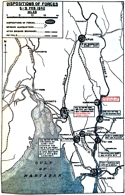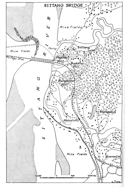8th (Frontier Force) Battalion, The Burma Rifles
The Battalion was raised at Thamakan as the 8th Battalion, The Burma Frontier Force on 1st October 1940 and was composed of Sikhs and Punjabi Mussalmans serving with the Burma Frontier Force. The battalion was designated the 8th (Frontier Force) Battalion, The Burma Rifles on 1st November 1940. Reinforcements for the 8th Battalion were found from and trained by the Burma Frontier Force. With the formation of the 9th (Reserve) Battalion in July 1941, reinforcements passed directly from the Burma Frontier Force to the 9th Battalion for additional military training.
On 19th June 1941, the Battalion was under the command of the Tenasserim Infantry Brigade Area and located at Tavoy, with one company at Mergui. The commanding officer was Lt. Colonel Thomas Ivan Bowers, an Indian Army Officer who had much experience of Burma. Bowers had served with the Burma Military Police during the operations in the Wa States in 1934, for which he received a bar to his Military Cross. Prior to the start of World War II, he became Commandant of the Myitkyina Battalion, Burma Frontier Force.
By December 1941, the Battalion was located at Moulmein, where it formed the major component of the Moulmein defence force, under the command of the Battalion Commander, Lt. Colonel Bowers. The Battalion came under the 2nd Burma Infantry Brigade Group. In January 1942, when Moulmein came under attack by the Japanese, the 8th Battalion fought well before being ordered to join the withdrawal across the Salween River to Martaban on the morning of 31st January. The whole battalion embarked at the Mission St. Jetty and upon disembarking at Martaban set of by road and rail for Kyaikto which was reached on 1st February 1942. The battalion strength, after casualties and missing men were accounted for, was about 540 officers and men. Practically all the Battalion's equipment had been saved although it had been necessary to leave the mules behind in Moulmein. A few stragglers rejoined the Battalion at Kyaikto.
On the 6th February 1942, the Battalion left Kyaikto for Hninpale, near Bilin, where the next day it came briefly under command of the 46th Indian Infantry Brigade, 17th Indian Infantry Division. The day after, the Battalion was re-assigned to the 16th Indian Infantry Brigade. Captain P.H.M. Galbraith took his ‘A’ Company and a detachment from the Battalion Headquarters Company on special assignment. For the next few days, the Battalion defended the area around Hninpale and the road and rail crossings over the Bilin River. On 17th February, a further change of command was made, this time the Battalion coming under the 48th Indian Infantry Brigade when this brigade came forward to reinforce the British line. During this period, the Battalion shifted position to the Bilin area. The Battalion came under attack by the Japanese later on 17th February. Three days later, a withdrawal was ordered and the Battalion found itself back at Kyaikto on 21st February.
The next day, the Battalion was ordered back to Mokpalin, near the railway bridge across the Sittang River, as part of the 48th Indian Infantry Brigade. Forming part of the defence of the southern part of Mokpalin, the Battalion kept up heavy fire on the approaching Japanese. The next morning, 23rd February 1942, the bridge over the Sittang River was blown, leaving much of the 17th Indian Infantry Division on the wrong side. The 8th Battalion was one of these units and later that evening withdrew to the river bank, all the while under heavy enemy fire. There were no boats or rafts left and the Battalion struggled to find any materials to make new rafts. Those that could attempted the crossing that night, under the cover of darkness.
The following morning, those who had survived the river crossing made their way in small groups to Waw where they received food and tea as the Battalion attempted to organise the survivors. These later went by truck to Pegu where the 17th Indian Infantry Division was reorganising. At Pegu, it was found that the Battalion was only about 125 men strong, of whom only 75 were armed. On 28th February, as no weapons were available to re-equip the men, all those without weapons were sent off under Captain Graham to Prome where they were to be re-equipped. By 2nd March, the much reduced Battalion had moved to Hlegu where it formed part of a composite battalion with the 4th Battalion, 12th Frontier Force Regiment and a company of the 7th Battalion, 10th Baluch Regiment. On March 6th, Captain Rannard left for Meiktila to organise and bring back reinforcements for the Battalion.
By now part of the 16th Indian Infantry Brigade, the Battalion joined the general retreat from Rangoon northwards towards Prome. At Zigon, on 13th March 1942, the Battalion became Divisional Troops, under the direct command of the 17th Indian Infantry Division. Prome was passed on 28th March and Allanmyo was reached on 30th March, where the Battalion stayed for three days. Meanwhile, at Meiktila, the unarmed party despatched from Pegu had arrived and were reorganised with additional reinforcements. On 28th March, this reinforcement party set off to join the Battalion, by way of Mandalay where a steamer was boarded which set off for Prome on 31st March.
The Battalion moved to Magwe on 6th April before crossing the Irrawaddy to Minbu on 10th April, where it came under the command of the 2nd Burma Infantry Brigade. At Lehla, a village about 30 miles from Minbu, on April 12th the reinforcements joined the Battalion, which had also taken F.F.8 of the Burma Frontier Force under command. Four days later the Battalion was ordered to return north to Minbu. ‘B’ Company under Captain Rannard was left behind near Taung-U with two platoons of F.F.8 to cover the approach up the west bank of the Irrawaddy, protecting the general withdrawal of the 2nd Burma Infantry Brigade. ‘B’ Company and the detachment from F.F.8 rejoined the Battalion at Zagu on the evening of 17th April.
The Battalion continued to accompany the 2nd Burma Infantry Brigade as advance guard on the arduous withdrawal to India up the Myittha Valley via Pauk, which was reached on 1st May. Contact was made with the Chin Hills Battalion, Burma Frontier Force, on 12th May. On May 13th, the Battalion took up defensive positions at a camp at the 51.4 Milestone on the Tamu Road, covering the withdrawal of the 16th Indian Infantry Brigade which passed through on 15th May. The Battalion reached Tamu on 17th May and crossed the Indo-Burmese border the next day. By May 25th, the Battalion was in camp at Milestone 109 on the Imphal-Dimapur road. The Battalion had come out of Burma in good shape and with its complete war establishment of weapons and ammunition.
The Battalion remained in camp until 24th June, where its strength was given as ten British Officers, 16 Governor's Commissioned Officers and 408 Burmese other ranks. Camping under pouring rain did not help the men recover from their arduous journey and many now fell sick with malaria and dysentery. On 24th June, the Battalion left with the 7th Battalion, The Burma Rifles for Ranchi. Eventually all the remnants of the Burma Army were collected together at Hoshiarpur where reorganisation took place. On arrival in India after the retreat, the 7th Battalion had about 300 men, mostly Gurkhas and Kumaonis formerly of the Burma Military Police and the 8th Battalion about 400 men, Punjabi Mussalmen and Sikhs formerly of the Burma Frontier Force. General Headquarters India proposed amalgamating the two battalions and the new unit was expected to then serve as a regular infantry battalion in an Indian division. The Government of Burma was uncomfortable with this and preferred to see the men returned to the Burma Frontier Force and Burma Military Police pool. Despite an initial intention to retain the identities of these battalions, in the end the men were formed into the 1st Battalion, Burma Regiment in September/October 1942, with Lt. Colonel Bowers becoming the battalion's first commanding officer.
Captain Hugh Graham served with the 8th Battalion, Burma Rifles during the 1942 campaign. His memoirs may be viewed here.
[The war diary of the 8th Battalion was destroyed during the retreat and was later reconstructed following arrival in India. The file is available at the National Archives at Kew as WO 172/980. A transcription of the file, together with extensive footnotes gleaned from other sources, can be read or downloaded here.]




